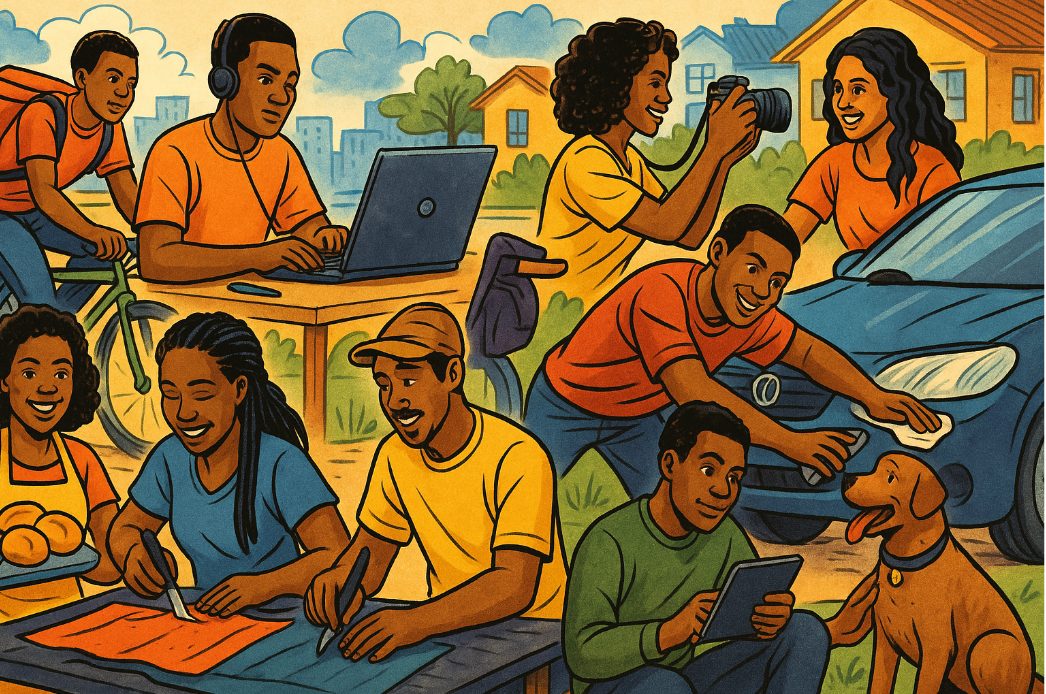The Numbers Don’t Lie
Payday loans provider Wonga South Africa conducted research (in the form of a large-scale survey with over six thousand respondents) in 2004, which revealed that people who make below R10,000 monthly now participate in a side hustle at a rate of 60%. This essentially means that two-thirds of lower-income South Africans need to start secondary income streams because their primary income fails to meet their basic survival needs.
The statistics unveil more insights when we dig a little deeper: people between 25 and 34 years old have taken to side hustles at a rate of more than 45% according to the research data. Young people employ entrepreneurial methods as a means of protection against economic challenges.
The large percentage indicates how poorly inflation, combined with rising living expenses and interest rates, affects the economy, according to James Williams, Digital Marketing Lead at Wonga. You can download the full survey data here if you’re interested.
When Dreams Meet Rent Money
A brief case study to show what the average hustler looks like: As a financial accountant, Lerato devotes significant time and energy to her profession, but her ultimate goal is to become a sports presenter. ‘The current economic state makes it impossible to achieve my dreams honestly,’ she states straightforwardly. She invests her free time in studying sports analysis while attending soccer matches and developing professional connections, and her day job enables her to sustain herself until she reaches her career goal.
The dual-income strategy has transformed into an ordinary reality for most young professionals. Young South Africans maintain their standard 9-to-5 jobs for financial stability while building their side business to pursue their actual professional dreams. This approach represents a practical response to an economic system that provides insufficient job security and minimal opportunities for meaningful professional satisfaction/fulfilment.
Another, Oratile, devotes her 20 years to studying pharmacy while developing her TikTok presence as she pursues her influencer career. The strategy involves growing her social media presence to attract brand attention and utilizing that platform for audition opportunities before transitioning into entertainment work. Her pharmaceutical degree? According to her, the degree functions as her safety net, which she deems as “an insurance.”
The Motivation Matrix
The Wonga study demonstrates that side hustle start-ups primarily stem from a few main reasons;
- 48% for financial support and living expense management.
- 18% for pursuing their passion
- 13% for building long-term wealth
- 11% for supporting others
- 10% for debt repayment
The research indicates these different motivations frequently overlap with one another.
Ronen Aires (A mental wellness leader and entrepreneur ) observes this generation and states: “I consider side hustles to be the defining feature of this generation. The label that best describes them would be ‘the natural-born customers.’ The side hustle matches perfectly with their personal brand elements, which they naturally possess. Their dream would become their primary source of income if they could achieve their goal in a perfect world.
The hustle stays strong during S.A.’s rolling power outages.
The ongoing electrical power crisis in South Africa has created additional challenges for the side hustle economy. Load shedding negatively affects 53% of side hustlers who experience financial losses ranging from R1,000 to R4,999 during power outages, according to research data.
Generation Side Hustle demonstrates its resilience through the fact that 38% of its members have adopted independent power solutions. Young entrepreneurs utilize solar panels in conjunction with generators and battery-powered equipment to continue operating their businesses as the country’s infrastructure crumbles.
The level of impact depends on both geographical location and specific business operations. The power outages drive Township-based food vendors to lose their customer base, but online traders suffer from disrupted internet access. These entrepreneurs display parental-generation-worthy adaptability through their innovative problem-solving strategies.
The Credit ‘Catch-22’
Young entrepreneurs face a significant challenge when they cannot access formal financial services, despite demonstrating solid business skills and financial responsibility. The conventional credit scoring system fails to detect both side hustle income and the necessary financial skills required for managing multiple income streams.
A destructive pattern exists where people begin side hustles because they cannot obtain formal credit, yet their informal income prevents them from qualifying for traditional loans. This financial system actively punishes innovative entrepreneurship by pushing people toward expensive non-bank loan options.
The study reveals that 20 percent of side hustlers acquired funding through credit or loan programs, while others used their savings and received family loans and developed their bootstrapping approaches. The process of securing business funding remains unfamiliar to many people, as traditional financial institutions often fail to recognize or appreciate this type of experience.
The Home-Based Revolution
More than eight out of ten side hustlers choose to operate their businesses from home, while only 12 percent operate exclusively online. Necessity often trumps the inconvenience of a home-based operation. Young people use their homes to establish production or service sites, such as nail salons, photography studios, and distribution centers.
The variety of business operations listed in the Wonga survey is remarkably broad and interesting. It includes everything from poem creation to handmade steel craftsmanship, specialty baked goods, and ‘bunny chow’ production. These activities serve as more than employment in many cases; they represent creative and cultural expression.
Building Tomorrow’s Economy Today
The new generation has developed an exceptional grasp of portfolio careers and multiple income streams, which previous generations simply did not need. This newer generation builds financial security through business diversification while developing flexible operations and acquiring skills that traditional workplaces have typically lacked.
The Wonga research overall observed that members of the younger generation had a ‘hopeful’ attitude about eventually turning their hustles into their primary source of income. The 9-to-5 job serves as a safety net, while the side hustle represents the dream of the future, all while mitigating risk. You gotta respect the hustle!







